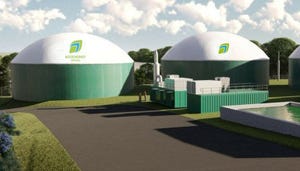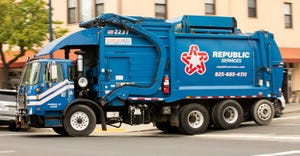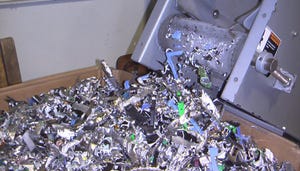business management: Food Disposers Help Grind Down Solid Waste Problems
November 1, 1998
Kendall Christiansen
While solid waste managers focus on the best ways to collect, process, transport and dispose of trash, they often don't appreciate the material that never makes it into the wastestream in the first place.
Food waste disposers, those handy appliances that attach under kitchen sinks and pulverize and liquefy food waste (also known as garbage grinders and disposals), should be recognized as sound waste reducers, according to a study conducted by Brooklyn, N.Y.-based research firm Konheim & Ketcham Inc.
Because food waste disposers have been accepted nationwide for several decades, their role in managing municipal solid waste (MSW) often is taken for granted. In fact, disposers help reduce residential waste by 7 percent to 10 percent.
The study focused on food waste disposers' environmental benefits and cost-effectiveness, and examined solid waste and sludge management policies and practices in several U.S. cities: Boston; Chicago; Los Angeles; Minneapolis/St. Paul, Minn.; Oakland, Calif.; Philadelphia; Portland, Ore.; San Diego; and Seattle, with a special focus on New York City.
With the exception of New York, which in 1997 became the nation's last urban area to allow food waste disposers in residences, other cities use food waste disposers in residential households extensively - in some cases, more than 75 percent of households rely strongly on disposers to reduce food waste.
New York City, which is on track to close its last remaining landfill, hopes to see the same success. While not the definitive solution to exporting solid waste to distant landfills, waste planners in the Big Apple know that food waste averages 15 percent of its residential waste stream - twice the national average, according to the U.S. Environmental Protection Agency. Thus, a 1 percent MSW reduction is equal to 40,000 tons per year that doesn't need to be collected, transported or landfilled.
Waste management systems incorporating food waste disposers are substantially more cost-effective to operate, according to Carolyn Konheim, president of Konheim & Ketcham and William B. Pressman, former research director for New York City's Department of Water Resources. Transportation costs are the largest component of waste management, representing about 80 percent of total MSW management costs. Using a well-designed sewer system to transport food waste materials that are 70 percent water (by weight) avoids more expensive and pollutant transportation to do the same job.
While composting can be cost-effective for food waste generated in large quantities by commercial food processing companies and major institutions, the separate collection by truck and composting of everyday residential food waste cannot compare to the cost of using food waste disposers.
For example, New York's data shows comparative costs to be in the range of $66 per ton for a system incorporating food waste disposers vs. $170 per ton for separate collection and disposal of food waste, not counting composting costs. These amounts are the net costs associated with relying on wastewater collection and treatment systems, noting the avoided cost of landfilling solid waste.
The study also found that food waste disposers have little effect on sewers, wastewater treatment, sludge management systems and water quality. None of the cities surveyed reported any problems with sewer maintenance, additional costs and concerns associated with wastewater treatment operations or impacts on receiving waters with widespread food disposer use.
New York found those concerns to be minimal - even when projected to when food waste disposers are in a majority of households.
Food waste disposers also assist with sludge management. An increasing number of municipalities are converting sludge to fertilizer rather than landfilling it. Adding organic material from food waste disposers contributes significantly to the beneficial properties of the sewage sludge, according to Ross M. Patten, president and CEO of Synagro Technologies Inc., a bio-solids management company based in Houston.
In addition, the additional organic material helps disperse those elements of sludge that are less desirable.
"Added food waste makes a richer product," Patten says. "We would much rather [have] food waste end up as fertilizer than decomposing and generating methane gas in a landfill."
For a copy of the study, call: (718) 330-0550. E-mail: [email protected]
Awards Roto Industries Inc., Anaheim, Calif., has been awarded the fully automated roll-out cart contract for the city of Grand Forks, N.D. The city purchased 11,900 100-gallon, fully automated carts and 120 300-gallon, fully automated carts.
Landfill Power Sheds Light on Minnesota Homes MINNEAPOLIS - A public-private coalition in Minnesota recently broke ground at the Elk River Landfill to install landfill gas-to-energy equipment. The gas-fueled generator system, manufactured and operated by Houston-based Power Strategies LLC, will provide power for approximately 250 area homes.
Although Anoka Electric Cooperative and United Power Association have the exclusive contract to supply Elk River Municipal Utilities (ERMU) with electricity, they granted an exemption to purchase power from the landfill gas-recovery project. Waste Management, Houston, which owns the landfill, assisted with the installation of the generating equipment.
This renewable energy project is funded in part by grants from government agencies, including the city of Elk River and through a long-term power purchase agreement between the landfill and ERMU.
The project is part of the Energy City program, and is a partnership between the city of Elk River and Energy Alley to promote the renewable energy and energy efficiency industry in Minnesota.
Energy Alley is a non-profit organization that works with businesses, government and advocacy groups to promote environmental excellence in policy, industrial management, land use and energy generation and use.
At press time, the system was on schedule to be fully operational by mid- to late-October.
You May Also Like


